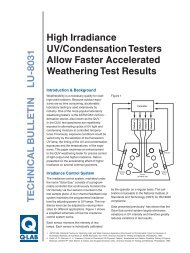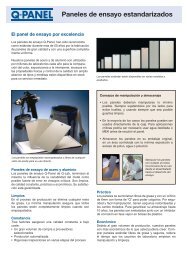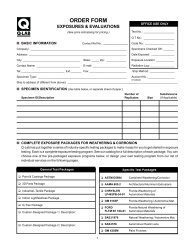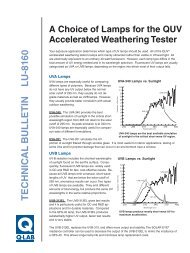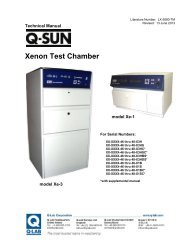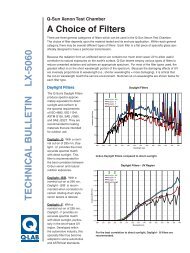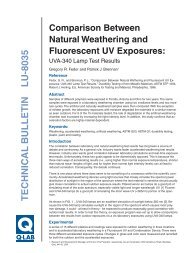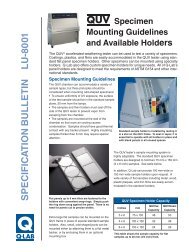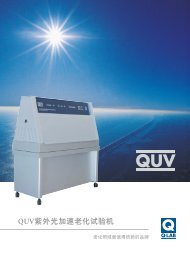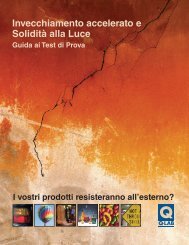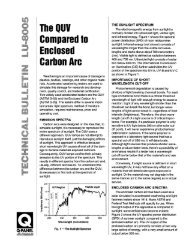Introduction to Cyclic Corrosion Testing - Q-Lab
Introduction to Cyclic Corrosion Testing - Q-Lab
Introduction to Cyclic Corrosion Testing - Q-Lab
Create successful ePaper yourself
Turn your PDF publications into a flip-book with our unique Google optimized e-Paper software.
<strong>Corrosion</strong>/Weathering Cycle Au<strong>to</strong>motive CCT Exposures<br />
For industrial maintenance coatings, the addition<br />
of UV has been found useful for improving correlation<br />
on some formulations. 16, 17 This is because UV<br />
damage <strong>to</strong> a coating can make it more vulnerable<br />
<strong>to</strong> corrosion. The <strong>Corrosion</strong>/Weathering Cycle<br />
consists of one week of Prohesion alternating with<br />
one week of QUV exposure.<br />
Electrolyte Solution 0.05% sodium chloride<br />
& 0.35% ammonium<br />
sulfate<br />
Solution Acidity pH between 5.0 and 5.4.<br />
Typical Duration 2,000 hours<br />
The <strong>Corrosion</strong>/Weathering exposure cycle is:<br />
1 hour Salt fog application at<br />
25°C (or ambient)<br />
1 hour Dry Off at 35°C<br />
(The dry-off is achieved<br />
by purging the chamber<br />
with fresh air, such that<br />
within 3/4-hour all visible<br />
droplets are dried off of<br />
the specimens.)<br />
Repeat for one week, then manually move the<br />
samples <strong>to</strong> a QUV Accelerated Weathering Tester<br />
and expose at the following cycle:<br />
4 hours UV exposure, UVA-340<br />
lamps, 60°C<br />
4 hours Condensation (pure<br />
water), 50°C<br />
Repeat for one week<br />
Manually move the samples <strong>to</strong> a CCT tester and<br />
repeat the whole procedure.<br />
The au<strong>to</strong>motive industry has taken the lead in<br />
researching cyclic corrosion tests. Consequently,<br />
most of the CCT procedures are geared <strong>to</strong>ward<br />
au<strong>to</strong>motive applications.<br />
GM 9 0P/B. According <strong>to</strong> the research done<br />
by the SAE ACAP Committee and the AISI, this<br />
is currently considered one of the preferred CCT<br />
methods for au<strong>to</strong>motive cosmetic corrosion<br />
(painted or precoated metals). GM9540P/B<br />
requires a 16 hour work day or an au<strong>to</strong>matic<br />
cycling test chamber. If performed manually,<br />
a sprayer is used <strong>to</strong> mist the samples until all<br />
areas are thoroughly wet. Parts should be visibly<br />
dry before each mist application. If performed<br />
manually, the samples should be left at the<br />
ambient conditions over the weekend. There are<br />
au<strong>to</strong>mated testers available that will perform this<br />
exposure in a single chamber.<br />
The GM9540P/B exposure conditions include:<br />
Electrolyte Solution 0.9% NaCl, 0.1% CaCl2<br />
& 0.25 NaHCO3<br />
Solution Acidity pH between 6.0 and 8.0.<br />
Typical Durations 80 cycles (1,920 hours)<br />
The GM9540P/B exposure cycle is as follows:<br />
– Thorough Salt Mist<br />
Application<br />
90 minutes Ambient Conditions<br />
(25°C, 30 - 50% RH)<br />
– Thorough Salt Mist<br />
Application<br />
90 minutes Ambient Conditions<br />
(25°C, 30 - 50% RH)<br />
– Thorough Salt Mist<br />
Application<br />
90 minutes Ambient Conditions<br />
(25°C, 30 - 50% RH)<br />
– Thorough Salt Mist<br />
Application<br />
210 minutes Ambient Conditions<br />
(25°C, 30 - 50% RH)<br />
8 hours Humidity (95 - 100% RH)<br />
8 hours Dry Off (60°C,



